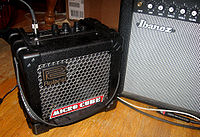
Roland Micro Cube
Encyclopedia

Battery (electricity)
An electrical battery is one or more electrochemical cells that convert stored chemical energy into electrical energy. Since the invention of the first battery in 1800 by Alessandro Volta and especially since the technically improved Daniell cell in 1836, batteries have become a common power...
powered modeling amplifier
Amplifier modeling
Amplifier modeling is the process of digitally emulating a physical amplifier such as a guitar amplifier. Amp modeling may appear as software, such as plugins for DAWs which may be aided by computer hardware accelerators, or may be part of a standalone device or amplifier...
distributed by the Roland Corporation
Roland Corporation
is a Japanese manufacturer of electronic musical instruments, electronic equipment and software. It was founded by Ikutaro Kakehashi in Osaka on April 18, 1972, with ¥33 million in capital. In 2005 Roland's headquarters relocated to Hamamatsu in Shizuoka Prefecture. Today it has factories in Japan,...
. It is a small, lightweight, portable amplifier, for use as a portable practice amp or when larger or more expensive amplifiers may not be practical. The Micro Cube is part of a Roland CUBE
Roland CUBE
Roland CUBE is a series of guitar and bass amplifiers manufactured and distributed by the Roland Corporation. The CUBE series use amplifier modeling technology.-Mobile CUBE:...
series of combo amplifiers, including the Cube 15, Cube 20, Cube 30, Cube 60, and Cube 80.
Features
The Roland Micro Cube features five different amp models, some clean and some featuring distortionDistortion
A distortion is the alteration of the original shape of an object, image, sound, waveform or other form of information or representation. Distortion is usually unwanted, and often many methods are employed to minimize it in practice...
, as well as an acoustic simulator and a vocal preamp. Also built in are several effects and a touch sensitive digital tuning fork
Tuning fork
A tuning fork is an acoustic resonator in the form of a two-pronged fork with the prongs formed from a U-shaped bar of elastic metal . It resonates at a specific constant pitch when set vibrating by striking it against a surface or with an object, and emits a pure musical tone after waiting a...
. Its power output is two watt
Watt
The watt is a derived unit of power in the International System of Units , named after the Scottish engineer James Watt . The unit, defined as one joule per second, measures the rate of energy conversion.-Definition:...
s and it has a five inch speaker
Loudspeaker
A loudspeaker is an electroacoustic transducer that produces sound in response to an electrical audio signal input. Non-electrical loudspeakers were developed as accessories to telephone systems, but electronic amplification by vacuum tube made loudspeakers more generally useful...
. The Micro Cube includes a standard quarter-inch input jack, an auxiliary quarter-inch input and an eighth-inch input (which are played without modeling or effects), and a headphone/record out quarter-inch jack.
Amp models

- Acoustic
- JC Clean - Modeled after Roland's own Jazz ChorusRoland Jazz ChorusRoland Jazz Chorus is the name given to a series of solid-state instrument amplifiers produced by the Roland Corporation in Japan since 1975. Its name comes from its built-in analog chorus effect, and its "pristine, clean sound" was often used in 1980s music by, for instance, funk musicians.The...
(JC-120) Amp - Black Panel - Modeled after Fender Twin Reverb Amp
- Brit Combo - Modeled after Vox AC30Vox AC30The Vox AC30 is a guitar amplifier manufactured by Vox and known for its "jangly" high-end sound. First introduced in 1958 due to the growing demand for higher-wattage amplifiers, it became an iconic amplifier for British musicians and soon for others....
Amp - Classic Stack - Modeled after Marshall JMP Amp
- R-Fier - Modeled after Mesa/Boogie Rectifier Amp
Controls
- GainGainIn electronics, gain is a measure of the ability of a circuit to increase the power or amplitude of a signal from the input to the output. It is usually defined as the mean ratio of the signal output of a system to the signal input of the same system. It may also be defined on a logarithmic scale,...
- VolumeLoudnessLoudness is the quality of a sound that is primarily a psychological correlate of physical strength . More formally, it is defined as "that attribute of auditory sensation in terms of which sounds can be ordered on a scale extending from quiet to loud."Loudness, a subjective measure, is often...
- Tone
- DelayDelay (audio effect)Delay is an audio effect which records an input signal to an audio storage medium, and then plays it back after a period of time. The delayed signal may either be played back multiple times, or played back into the recording again, to create the sound of a repeating, decaying echo.-Early delay...
/Reverb - Flanger/PhaserPhaser (effect)A phaser is an audio signal processing technique used to filter a signal by creating a series of peaks and troughs in the frequency spectrum. The position of the peaks and troughs is typically modulated so that they vary over time, creating a sweeping effect...
/ChorusChorus effectIn music, a chorus effect occurs when individual sounds with roughly the same timbre and nearly the same pitch converge and are perceived as one...
/TremoloTremoloTremolo, or tremolando, is a musical term that describes various trembling effects, falling roughly into two types. The first is a rapid reiteration...
Updated Versions
Since its release in 2004, the Micro Cube has been released in two more colors; white and red. Additionally, the Micro Cube RX has been released in 2008, which is a slightly larger version with 4x4" drivers.The Micro Cube retails for $129.99, the RX, $249.99

